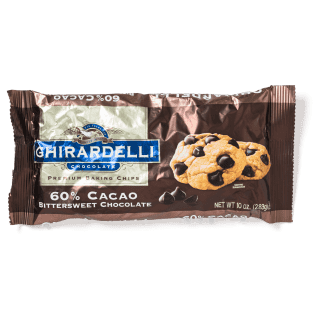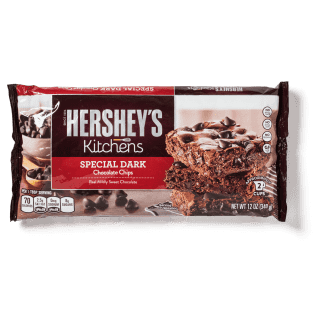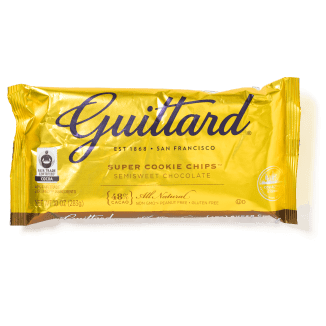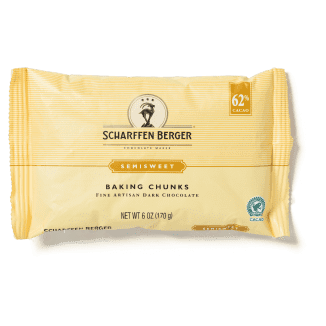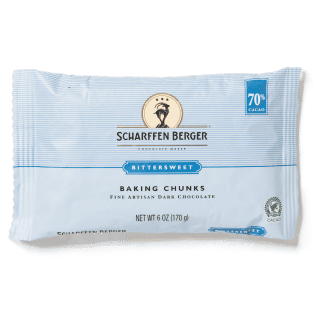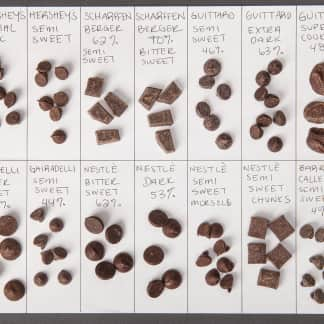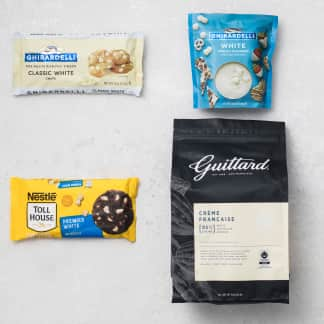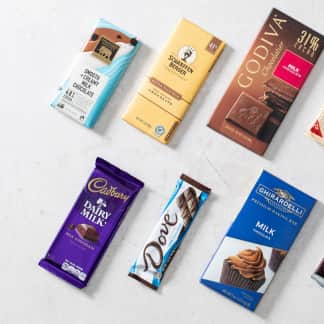Chocolate chip cookies are America’s favorites, according to The Great American Chocolate Chip Cookie Book (2013) by Carolyn Wyman. Invented in the 1930s, the recipe called for semisweet chocolate. Today, chocolate chip choices abound, and dark chocolate—which includes “semisweet” and “bittersweet” since there’s no legal distinction—has come a long way. Even Nestlé, which in 1940 launched chocolate morsels, now sells four styles of dark chocolate chips (plus quirky varieties including peanut butter, mint, and pumpkin spice). We bought 14 products labeled dark, special dark, bittersweet, or semisweet and sold as chips, oversize “super” chips, morsels, or chunks. In blind tastings, we sampled them plain and in our Perfect Chocolate Chip Cookies (May/June 2009).
A few years ago, when dark chocolate bars got fancy with cacao percentages and exotic origin stories, chips were left behind. They were also made more cheaply: To scrimp on costly cocoa butter and retard melting, manufacturers made them with less fat, resulting in firmer and grittier chips. Today, most chocolate chips we sampled were just as creamy and rich as bar chocolate, called themselves “premium” or “artisan,” and touted cacao percentages. Prices rose, too: When we tasted dark chocolate chips in 2009, prices ranged from $0.19 to $0.30 per ounce, but this time around they cost around $0.27 to $0.74 per ounce.
“Pea-Size Pieces”: The Original Chocolate Chips
Back in the 1930s, innkeeper Ruth Wakefield had a hit on her hands when she chipped a Nestlé’s semisweet chocolate bar into “pea-size” pieces and baked it into brown sugar cookies at The Toll House Inn in Whitman, Massachusetts, just south of Boston. Nestlé bought the rights to the recipe for Wakefield’s chocolate chip Toll House Cookies, printed it on the 7-ounce bar wrapper, and even scored the chocolate bar to help home cooks break it into chips. In 1940, when Nestlé created chocolate morsels (the company’s name for chips), Wakefield’s recipe went on the back of the bag, where it can still be found today.
While we wondered if this premium trend was mere hype, the truth was in our results: Tasters recommended all 14 products, with reservations about three. The top two even earned our highest recommendation.
We had surprising preferences. Since the cookie recipe was invented using so-called semisweet chocolate, we’d worried that darker, more bitter chips might seem out of place—but our tasters actually preferred them. “This is the perfect chocolate chip cookie,” a happy taster wrote about the cookie featuring our winning chip.

Why were darker chips more successful? The ratio of sugar to chocolate. A chocolate’s cacao percentage tells you how much of the candy comes from the cacao bean. Cacao beans are fermented, dried, roasted, cracked, and winnowed to produce nibs, which are ground into a paste called chocolate liquor. This contains cocoa butter and cocoa solids. In chocolate chips, once you account for the cacao, the rest is primarily sugar. The United States Food and Drug Administration only mandates that dark, bittersweet, or semisweet chocolate have at least 35 percent cacao; beyond that, manufacturers are free to tweak processes, recipes, and nomenclature. So one company’s “semisweet” offering can actually have a higher cacao percentage than another company’s “bittersweet.” Our lineup had a huge range, from 40 percent to 70 percent cacao. While none tasted bad—they’re chocolate, after all—when compared side by side, the lower-cacao chips seemed too sweet. All but two of these products contained more sugar than any other ingredient. About our favorite “darker” chip, a taster wrote, “the bitterness of the chocolate complements the cookie dough.”

Our top two chocolate chips contain 60 percent and 63 percent cacao; most lower-ranked chips were in the 40 to 50 percent range. The third-place product, which we estimated at 47 percent cacao (its manufacturer withheld details), listed a unique ingredient: Dutch-processed cocoa powder, which is alkali-treated to neutralize acidity. This addition boosted its chocolate flavor.
Fat was also a factor. The total cacao percentage doesn’t reveal how much fat comes from cocoa butter and how much from cocoa solids. Two 60-percent-cacao chocolates can have very different ratios of fat to solids, as long as they total 60 percent. Our winning 60-percent-cacao chip contained about 40 percent fat, the highest of the lineup. Lower-ranked chips dipped as low as 25 percent fat. In our top chip, that extra creaminess won tasters’ highest praise. Only one other chip contained this much fat—but it suffered from other woes: its proportions. In addition to fat and cacao percentages, we discovered that shape was integral to chips’ success in cookies. When chips were too angular, they didn’t disperse evenly in cookie dough. This resulted in some virtually chip-free cookies, while others contained so many chips that, without enough dough to protect them, the chocolate scorched in the oven and looked unappealing. Traditional dewdrop-shaped chips or chunks with curved edges distributed more evenly.
It’s Not (C)hip to Be Square
Our tasters preferred chocolate chips with higher cacao and fat percentages, but we found that shape mattered, too. Chips with traditional dewdrop shapes, including our winner, Ghirardelli 60% Premium Baking Chips, distributed evenly when we portioned cookie dough. While tasters raved about the flavor of the two lowest-ranked chips, both by Scharffen Berger, they disliked how the rectangular pieces dispersed in cookies.
Better Chips
While fresh, homemade chocolate chip cookies really can’t fail, our winning chips will give yours an advantage. Their high cacao percentage helps guarantee deep, rich chocolaty flavor; their bittersweet profile, with more cacao than sugar, ensures a milder sweetness that balances the sugary cookie; and a generous amount of cocoa butter (plus milk fat for smoother melting) gives them a creamy texture. Our winner, Ghirardelli 60% Premium Baking Chips, hits all the right notes, and the slightly oversize chips provide just a little more chocolate in every bite. Made with the same ingredients as our favorite dark chocolate bar, also from Ghirardelli, these chips won’t let you down.

- Taste plain
- Taste in Perfect Chocolate Chip Cookies
- Weigh a sample of chips to determine average chip weight
- Intense chocolate flavor
- Higher percentage of cacao (components from cacao bean)
- Less sugar (sugar not listed first on ingredient list)
- Higher percentage of fat, which equates to smooth, creamy texture
- Rounded, compact chip shape, which ensures easy scooping when portioning cookie dough and even distribution of chips throughout dough

